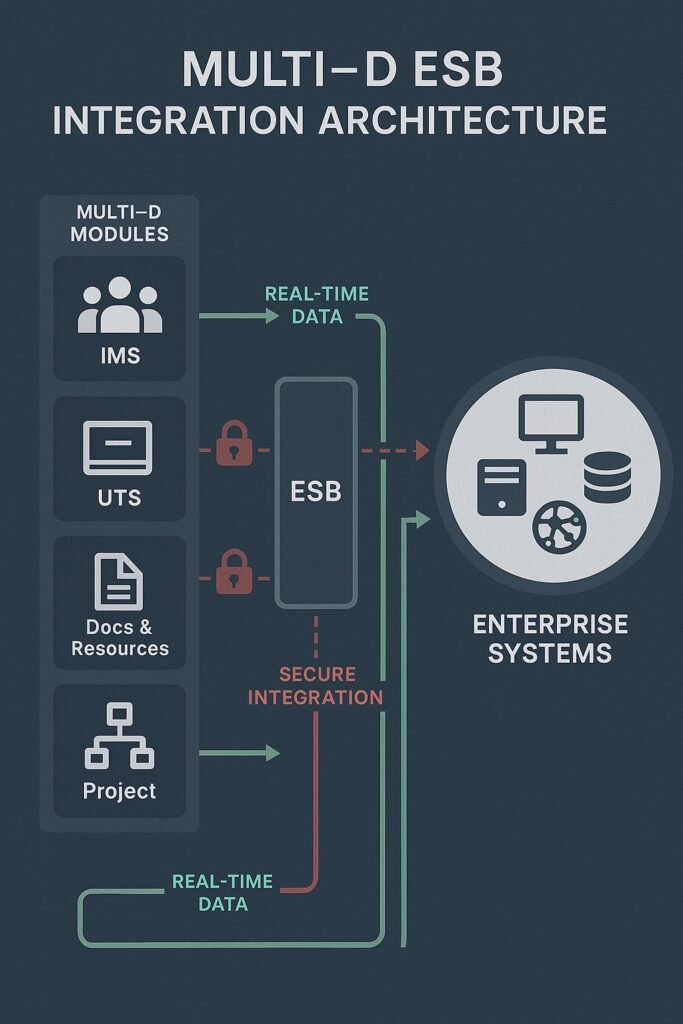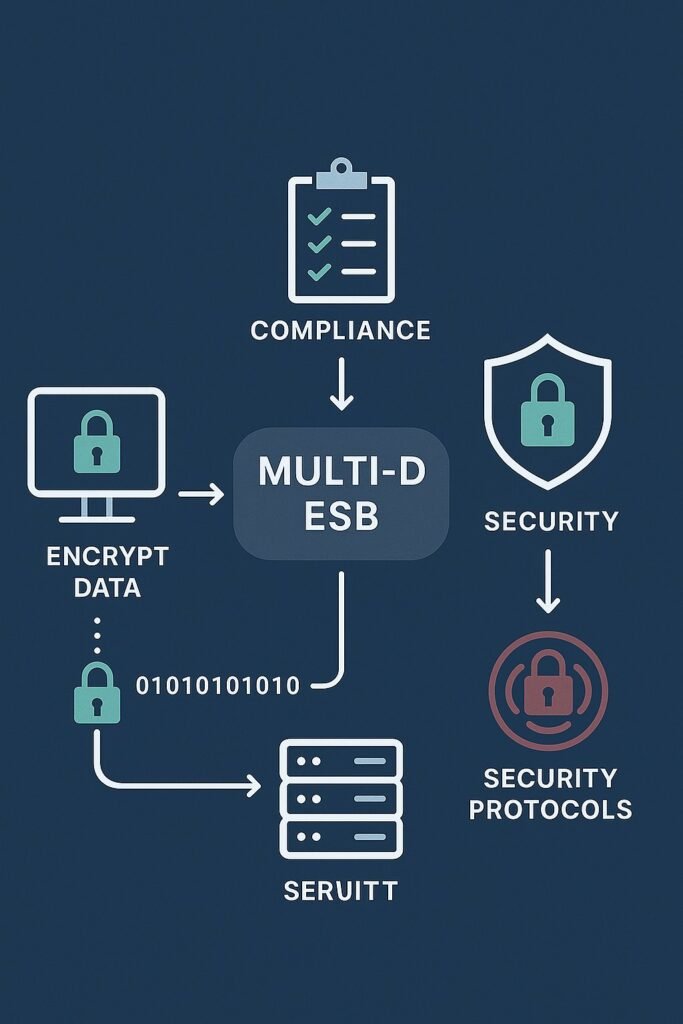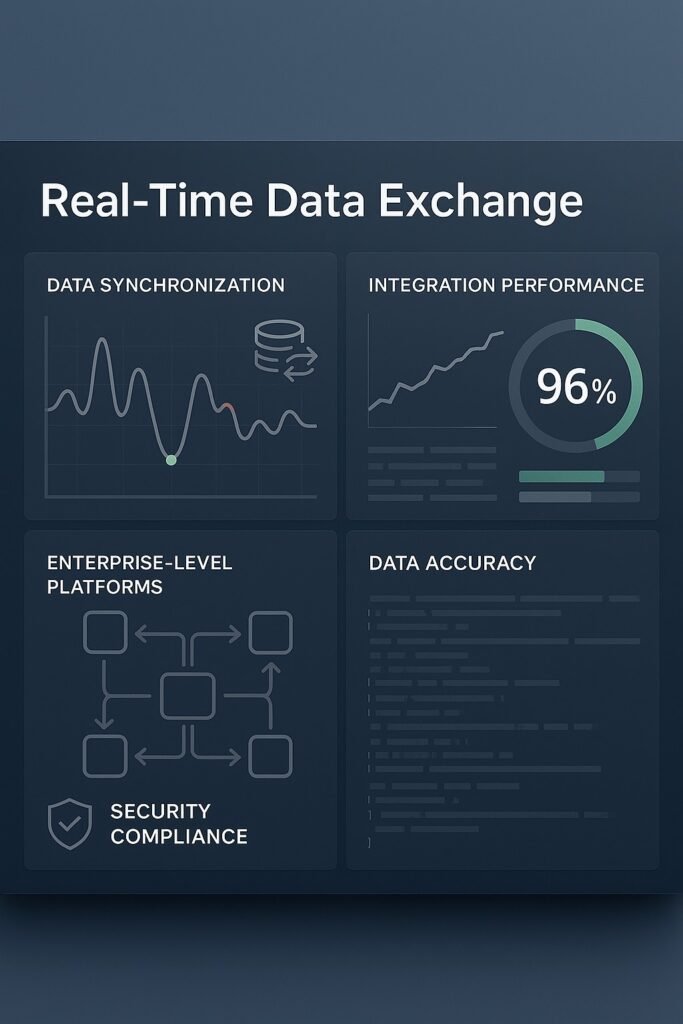🧩 Visual Frameworks & Illustrations



🏗️ Project Overview
Under my strategic leadership at ASE, the MULTI-D Enterprise Service Bus (ESB) was developed and implemented as the critical integration backbone within the Multi-D digital platform. This robust solution enabled seamless, secure, and efficient data exchange across multiple enterprise-level systems and diverse business processes in complex nuclear and engineering construction projects. My direction ensured real-time, accurate, and secure integration of extensive data flows, significantly enhancing operational efficiency, project transparency, and enterprise agility throughout Rosatom’s engineering division.
🛠️ Key Objectives & Challenges
Seamless Enterprise Integration: Establish a secure, high-performance integration platform to unify multiple complex corporate systems and facilitate consistent data management.
Real-Time Data Exchange: Enable immediate and accurate data synchronization among core Multi-D modules (IMS, UTS, Docs & Resources, Project), enterprise platforms, and external systems.
Enhanced Data Security and Compliance: Ensure strict adherence to regulatory standards and rigorous security protocols across all integrated data exchanges.
Operational Transparency and Reliability: Improve operational insights, transparency, and reliability through consistent and secure data flows between enterprise modules and external partners.
🌐 Technological Approach & Innovations
Centralized Integration Hub: Implemented an advanced Enterprise Service Bus (ESB) based on robust, open-source solutions such as Apache ServiceMix, Talend ESB, Mule ESB, WSO2 ESB, and Apache Synapse ESB, supporting high-speed, secure, and scalable integration.
Real-Time Data Synchronization: Leveraged event-driven architecture (EDA) and Service-Oriented Architecture (SOA) to facilitate real-time data synchronization across Multi-D modules, ensuring rapid, accurate data exchange and operational responsiveness.
Advanced Data Transformation (ETL): Integrated sophisticated ETL (Extract, Transform, Load) mechanisms for data normalization, ensuring seamless compatibility and consistent data quality across diverse enterprise systems.
Scalable and Secure Communication: Ensured secure and reliable data flows through robust authentication and authorization protocols, as well as encrypted data transmission, maintaining compliance with strict security standards.
Integration Analytics and Monitoring: Developed real-time monitoring and analytical tools for immediate visibility into data exchanges, operational status, and performance indicators across all integrated systems.
📊 Results & Measurable Outcomes
Operational Efficiency & Speed: Achieved a significant increase (approximately 40%) in the speed and efficiency of enterprise-level data exchanges, enhancing overall operational agility and responsiveness.
Data Accuracy and Reliability: Successfully ensured high levels of data accuracy and consistency, significantly reducing integration errors and discrepancies across enterprise systems.
Enhanced Security and Compliance: Maintained rigorous data security and compliance standards, significantly minimizing operational risks and enhancing stakeholder trust.
Enterprise-Level Transparency: Improved operational transparency and oversight through real-time analytics, enabling informed decision-making and proactive risk management across construction projects.
Cost and Resource Optimization: Delivered substantial operational cost savings and efficiency gains through streamlined integration processes, reduced manual interventions, and optimized resource allocation.
🏹 My Leadership Role & Contributions
Directed comprehensive strategy formulation, architectural design, and successful deployment of the MULTI-D ESB solution within ASE’s broader digital transformation initiative.
Managed a specialized team of integration experts, ensuring close collaboration with various stakeholders, efficient project execution, and continuous innovation.
Led the implementation of advanced integration technologies, achieving seamless and secure enterprise-level data management, real-time synchronization, and operational reliability across multiple complex systems.
Spearheaded the adoption of open-source integration solutions, ensuring scalability, flexibility, and cost-effectiveness, while maintaining rigorous security and compliance standards. Provided strategic oversight in integrating innovative analytics and monitoring tools to deliver real-time insights into integration performance, data consistency, and operational effectiveness.
🏗️ Strategic Importance Conclusion
The successful implementation of MULTI-D ESB under my leadership was pivotal in enhancing ASE’s operational agility, data consistency, and integration reliability. By establishing a unified, secure integration environment, I significantly improved enterprise efficiency, transparency, and responsiveness, strengthening ASE’s competitive advantage and technological leadership within the complex engineering and construction sectors, particularly in the demanding field of nuclear power engineering.

